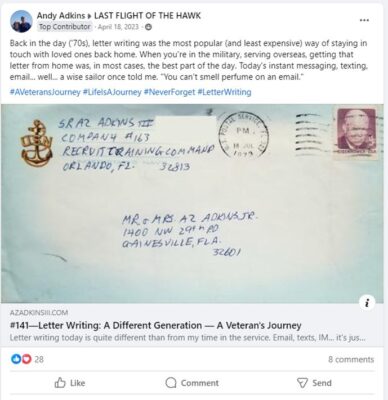
I’m a writer. I’m also a blogger—weekly, A Veteran’s Journey.
In my last article (“Blogging 101: Who, What, When, Where, &… Why”), I ventured into the big “why” you should blog and offered a few examples of different types of blogs. After all, blogging is not for everyone. I also discussed various methods to set up your blog (platform, content, application).
This month, I’ll focus more on how you can build readership by sharing your blog posts on various platforms.
Ready? Let’s go.
Blogging Statistics
Similar to last month, I wanted to share a few statistics about blogging—this time, focusing on the marketing aspect.
- Does blogging help with book sales?
- Blogs increase the chance of ranking on Google by over 400% (Tech Client).
- 33% of bloggers don’t make any money from their blog (TechJury).
- Almost half of all food blogs get 50,000+ visits per month (RankIQ).
- 90% of bloggers use social media to guide readers to their content (Orbit Media).
- Three in five readers will share blog content on social media without reading it first (Optinmonster).
- How long should my blog be?
- The highest-ranking content averages less than 1,300 words (Search Metrics).
- Nearly half of consumers would like to see more video content (Optinmonster).
- Shorter headlines are more effective and increase click-through rate by 21% (Optinmonster).
- 30% of readers prefer posts with numbers in the title (CXL).
- What are the major obstacles to blogging?
- Nearly 2 in 5 bloggers struggle to stay consistent (Semrush).
- Finding time to create content is the biggest struggle for bloggers (Orbit Media).
Social Media
I share my own blog, A Veteran’s Journey, on the following social media platforms. Some in the industry call this “cross-promotion.”
- Facebook
- My personal feed
- My “author’s page” feed
- Multiple FB Groups (about 12-15, depending on the blog content)
- Instagram–my personal account
- Pinterest–my personal account
- LinkedIn–my personal account
- Goodreads–my author account
- Twitter (X), though I stopped posting to Twitter/X late last year.
I use WordPress as my blogging platform. “Buttons” at the bottom of my blog allow me to post directly to Facebook, LinkedIn, and Pinterest. I have to “manually” share it with my Instagram account. I also periodically send my blog directly to individuals via email.

I schedule my blog to publish on Tuesday mornings and Friday afternoons (“Navy Friday Funny”). Once it’s published, I manually spend about 10-15 minutes “sharing” it to the various social media platforms, usually while sipping a nice, hot cup of strong Navy black coffee. This gives me the opportunity to “customize” the feed post that I’m sharing to a specific group.
Even though my blog (usually 1,500–2,200 words), is automatically emailed to my list of subscribers, I share it from the actual blog post. For example, I’ll click on the “Share with Facebook” button, which opens a Facebook interface, then I’ll select which Facebook Group to share my blog, and type in a custom message for that group.
You also have to be careful about Facebook Groups. Many of these are “private” groups and have their own sets of rules. For example, several groups I follow do NOT allow sales, so I have to be cautious about what I post as well as the content of my blog. Others are less restrictive, yet you’ll commonly see dozens of people hawking their wares.
The key is to understand your audience and abide by their rules. Otherwise, you may find yourself in what’s commonly called “Facebook Jail.”

Hashtags
Hashtags are synonymous with social media. Basically, it’s a metadata “tag” that is prefaced with a hash symbol, “#.” Hashtags allow you to mark your territory, so to speak, with other social media content that falls in the same category.
In other words, I use #AVeteransJourney on all my social media platforms, especially when I share my blog. That way, if someone searches the web for #AVeteransJourney, they’ll (hopefully) find my blog post. Of course, they’ll also find other social media content that uses the same hashtag, but that’s not avoidable.
As you can see in the example image above, I posted my blog to the Facebook Group “Last Flight of the Hawk” (my old aircraft carrier, USS Kitty Hawk), and used four hashtags: #AVeteransJourney, #LifeIsAJourney, #NeverForget, and #LetterWriting. I almost always use the same first three for every blog; the last one is more specific to that particular blog post.
SEO… what?
SEO is short for Seach Engine Optimization. If you’re not familiar with this term, it’s basically a method to help improve the visibility of your website (or blog) when people search for products or services (or topics) using Google, Microsoft Bing, and other search engines.
There’s a “sketchy” method to this madness and while I try to follow some of the practical tips offered by SEO organizations, I find that it’s a confusing topic and far more complex than I care to write about in this blogging article.
In my own experience, I’ll quote one of my favorite theologians, Chet Adkins: “What works today won’t work tomorrow. What doesn’t work today, may work tomorrow.”
As a quick aside, WordPress provides an optional add-on, Yoast SEO, that provides inline tips to optimize my blog post content.
Guest Blogs
Another method to promote your blog is to utilize Guest Blogs. This works both ways. One, you can write a guest blog for a friend, colleague, or just someone who accepts outside bloggers. Posting on someone else’s site gives you the opportunity to market yourself to their followers. That is, another audience.
Two, have someone else write a blog and post to your site as a “guest blogger.” You want to be careful with this, because as pointed out above, you need to ensure the guest blog will not take away from your following.
The best advice I can give you is to follow other blogs in your niche. Once you get a feel for what they write, reach out to see if there’s a possibility of trading blog posts. You write one for them, they write one for you. You’ll be credited as the author, which gives you the opportunity to link back to your author site or your blog.
If you weren’t aware, WAG’s own Hogtowne Quill is a “guest” blog. Multiple people submit various stories. Why not yours?
Winding Down
In my opinion, I think it’s more important to write, whether it is a book or a blog. As mentioned earlier, I write a weekly blog. After a year, I’ve got 52 (ish) blogs. That’s 52 stories, or a collection of stories, such as A Veteran’s Journey, Volume 1: A Collection of Short Stories.
I just published Volume 3 a few months ago.
Another suggestion is to include internal links in your blog. As you grow your blog and your audience, you’ll have several things you can link to. Depending on your blog niche, you may link to recipes (if you blog about cooking); you may link to your books (if you have books to sell); you may link to photographs (if you’re a photographer selling your artwork).
You get the idea. The internal links not only help with promoting your site, they also help the internet search engines’ SEO algorithms.
There are literally an unlimited number of ways to market your blog. One of the best pieces of advice I ever received was to start out small, find your audience and your niche, then expand on both (audience & niche).
Like the saying goes, you’ll have nothing to share if you don’t start blogging.
Happy blogging!
Blogging Resources
- Adam at Blogging Wizard: https://bloggingwizard.com/how-to-promote-your-blog
- Darren Rowse at ProBlogger: https://problogger.com
- Ankit Singla at MasterBlogging: https://masterblogging.com
- Blogging Guide: https://bloggingguide.com
